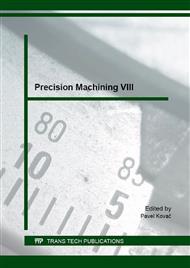p.39
p.45
p.51
p.57
p.63
p.68
p.74
p.80
p.86
The Formation and Behaviour of Residual Stresses with Finished Surfaces
Abstract:
The single tool grains affect the workpiece surface during grinding in the separated areas of deformation. The elastic and consequently plastic deformations occur at the engagement of grains. The friction of grain and material likewise the friction of elementary chip and grain acts simultaneously. These phenomena are accompanied with an origination of great amount of heat and high pressures and that is the reason for residual stress origin and formation in the ground surface. The residual stress is an important factor in influencing usable properties of machine parts. The stress influences not only the dynamical load capacity of surface but the durability and quality of design units as well. This stress is considered as the source of so called technological notches, having an influence on corrosion resistance, wear resistance, and dimension stability of machine parts.
Info:
Periodical:
Pages:
63-67
Citation:
Online since:
February 2016
Authors:
Keywords:
Price:
Сopyright:
© 2016 Trans Tech Publications Ltd. All Rights Reserved
Share:
Citation:


